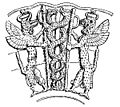Serpent (symbolism) facts for kids
Snakes, also known as serpents, are one of the oldest and most common symbols found in stories and beliefs from around the world. The word 'serpent' comes from a Latin word meaning 'crawling animal'. For a very long time, snakes have been part of ancient traditions and can represent different ideas, both good and bad.
Snakes in Ancient Beliefs
In some cultures, snakes were seen as symbols of new life and growth. For example, the Hopi people of North America had an important yearly snake dance. This dance celebrated the joining of Snake Youth (a spirit from the sky) and Snake Girl (a spirit from the underworld). It was also done to help nature grow and bring good crops. During the dance, live snakes were carefully handled. After the dance, the snakes were released into the fields to help make sure the crops would grow well.
Images for kids
-
The Sumerian deity, Ningizzida, is accompanied by two gryphons Mushussu; it is the oldest known image of two snakes coiling around an axial rod, dating from before 2000 BCE.
-
Mami Wata, important in African and African-American religions
-
The "libation vase of Gudea" with the dragon Mushussu, dedicated to Ningishzida (twentieth century BCE short chronology). The caduceus is interpreted as depicting the god himself.
-
Snake decoration on Bronze Age pot from Rumailah, Al Ain
-
The Brazen Serpent (watercolor circa 1896–1902 by James Tissot)
-
Statue of Asclepius
-
Hoysala sculpture of a Naga couple, Halebidu














